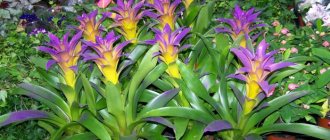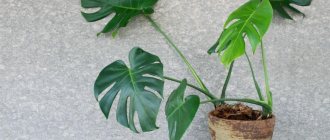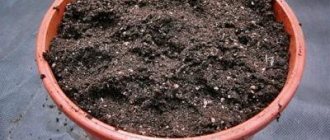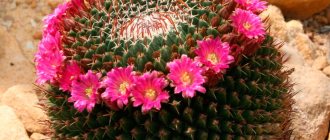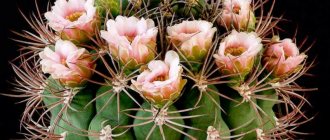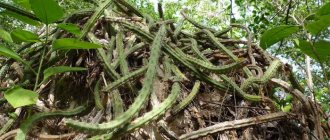Guzmania is a beautiful flower that is of tropical origin. At the same time, caring for it is easy; the plant blooms beautifully and reproduces at home. In order for Guzmania to please the eye for a long time, you need to know its natural habitat and choose the right soil, maintain optimal air temperature and lighting, and water it in a special way.
Guzmania - home care and its features
Flower growers love guzmania for its originality and bright colors of inflorescences, which can be yellow, red, burgundy and other colors. Indoors, guzmania, the care of which at home will require the owner to follow certain rules, grows no more than half a meter and, taking into account the specifics of its cultivation, will form a healthy and beautiful bush.
Guzmania will form correctly only if the correct container is selected for planting it - the pot should be small and shallow, since the plant does not have a voluminous root system.
In the wild, exotic guzmania grows on the trunks of tropical trees, and this suggests that ordinary soil is not suitable for its proper development, and the best option would be a mixture of sphagnum moss, peat chips, sand and turf soil in a 1:1 ratio.
When breeding guzmania, it is important to know that it is better to plan all the feeding needed by the plant for the spring, and this indoor flower must be replanted immediately after purchasing it, doing this with special care, since the roots are delicate and can be damaged during replanting. The temperature in the room with guzmania should fluctuate between +18ﹾ25+ ... ﹾ C in the active growth phase and not exceed +20ﹾ C during the dormant period, that is, in winter.
lighting - the best option for guzmania would be indirect bright light, but direct rays should not be allowed to hit the leaf rosette, as this will burn the leaves.
It is ideal to place a container with guzmania on windows facing east or west, but on the south side the plant will not be comfortable, so you will need to create partial shade.
Guzmania on the windowsill - in the photo
Guzmania, which is quite easy to care for at home, is an unpretentious plant, but it is not always possible to achieve flowering, so flower growers have developed a special technology:
- The plant along with the pot should be placed in a plastic bag, creating greenhouse conditions, and fruits – bananas and others – should be placed in the bag along with it;
- When the bananas begin to rot, a gas will be released into the atmosphere of the greenhouse, stimulating the growth and development of flowers;
- You should not remove the film until the first inflorescences appear, and rotting fruits need to be changed regularly.
Young light leaves formed in the center of the plant will actively grow, stretching upward and forming a bright, elegant inflorescence.
Guzmania: what to do after buying a plant?
The plant, carefully delivered home from the store, needs to be replanted. The peculiarity of the transplant is that it is carried out only once - after purchase. It is not advisable to disturb the guzmania anymore, so you need to immediately take care of the correct substrate and a suitable pot.
To prepare the substrate, you can mix the following components in equal quantities: peat, turf soil, sand and sphagnum moss. The first layer at the bottom of the pot is expanded clay. It is better to use a pot that is heavy, wide and not high.
How to water Guzmania and what fertilizers to use
The flower loves moisture, but not every gardener knows how to water guzmania - this must be done regularly, following a certain technology - water must be poured into the leaf rosette, and during the warm season, the green part of the flower must be regularly sprayed.
Watering is one of the most important factors in the harmonious development of healthy and lushly blooming guzmania, so it is important to follow the basic rules of watering:
- Water is not poured into the soil near the plant, but directly into the leaf rosette, as mentioned above, and the moisture that appears in the pan immediately after watering must be immediately removed;
- Watering the soil in a pot should be done in exceptional cases when the air temperature in the home is high for guzmania;
- There is no need to remove water from the pan if the air temperature in the room is high and the humidity level is insufficient for guzmania;
- In warm weather, guzmania should be watered every day, and in the resting phase (autumn and winter), watering should be reduced to 2 times a week;
- Regardless of the temperature conditions indoors and outdoors, guzmania needs daily spraying, which should be done with warm water.
And, despite the fact that guzmania needs a large amount of moisture, excessive amounts can negatively affect the development of the plant.
In order for guzmania to bloom magnificently and for a long time, it must be properly fed, and this must be done with fertilizers of mineral and organic origin. Balanced fertilizers for guzmania can be obtained in a specialized store, but it is not recommended to prepare the fertilizer yourself, as the proportions of the components may be disrupted.
Guzmania, the rosette of which is its main decorative element, needs feeding from the moment the plant begins to bloom, and this usually happens at the end of summer. You need to water the plant with fertilizer in the same way as with ordinary water - through an outlet, but the nutrient solution should not get into the soil near the guzmania. If the rules for feeding the plant are followed correctly, guzmania will delight you with abundant flowering for several months.
Bloom
The flowering of guzmania is why this plant is grown at home. Interesting fact: guzmania blooms once in its life , and after flowering it dies, leaving “offspring”. But it may not bloom in the first year after planting, but much later. It all depends on the growing conditions.
During flowering, the plant needs abundant moisture in the substrate and monthly fertilizing from March to September. The duration and quality of flowering is affected by lighting - guzmania needs as much bright diffused light as possible.
Why guzmania does not bloom and other growing issues
Like all plants, guzmania can become unwell. Among the many reasons why guzmania does not bloom and dies, the most popular are:
- Failure to comply with basic care rules;
- Plant damage by parasitic insects;
- Flower infection.
The most common reason why guzmania does not bloom is the rosette and root system of the plant rot, so if rot is detected on the stem, you should immediately check the moisture level in the pot and reduce watering, and if necessary, replant the flower.
If Guzmania is damaged by insects, the leaves curl and the plant dies without timely assistance, so leaves infected with parasites must be wiped with a soft cloth or sponge soaked in a solution of laundry soap.
If the leaves of Guzmania and its trunk are covered with gray and black spots, the plant is affected by a fungus, which can be destroyed by spraying with a fungicidal solution. An incredibly beautiful guzmania plant, which should be cared for regularly at home, will certainly delight you with healthy and abundant flowering and will decorate every windowsill.
Humidity
Like any tropical plant, guzmania requires high air humidity of 80% and above. She is unlikely to like the dry or moderately humid air of city apartments. The plant suffers especially during the heating season. To create familiar microclimate conditions for a tropical guest, you need to perform the following steps:
- Remove guzmania away from radiators.
- Spray the plant with filtered water at room temperature daily.
- Place a tray with wet pebbles or expanded clay near the pot.
After all, you can simply turn on the humidifier . But humidity above 60% can be harmful to the human body, so it is better to create a special microclimate around the plant pot, taking note of the simple tips given above.
Reproduction
After flowering, the mother plant dies, leaving behind the children. Babies are young lateral processes extending from the dry maternal rosette. They have their own roots. from 1.5 cm long with roots can be cut off and planted in a separate pot.
First, the baby will need a temporary pot filled with orchid substrate. The young plant should be placed in a warm, bright room and high humidity should be created around it. This can be done using a mini-greenhouse - just cover the pot with a transparent plastic bag for a while.
When the plant gets stronger and begins to grow, the greenhouse can be removed, and the young guzmanias can be transplanted into a permanent pot.
Description
The height of the plant is up to 80 cm, the long leaves form a rosette with a diameter of 20-25 cm. The inflorescence is located in the center, erect, bright.
The peculiarity of flowering is the bright color of the bracts, which lasts for a very long time. The flowers themselves are unremarkable. This plant is an epiphyte and is not a parasite.
Important: the juice of the plant can cause skin irritation and allergies, so people with a tendency to allergic reactions should not get guzmania.
Lighting and air temperature
A very important point in growing Guzmania is the level of illumination in the room. The most suitable place for it would be the western or eastern side , since direct sunlight on the south has a detrimental effect on the plant, and on the north it may not bloom.
When caring for it, it is very important that there is warm and humid air in the room where the home guzmania flower grows. In summer, the optimal temperature will be twenty-five degrees, and in winter no lower than eighteen degrees. Air humidity should be at eighty percent.
The room must be regularly ventilated, but avoid drafts, which delay the flowering period and cause a number of diseases.
Features of different types (briefly)
Most species are difficult to classify for novice florists, since all guzmanias have a flat root rosette, assembled according to the principle of a cabbage head with a funnel-bowl (for storing moisture and food) and long, narrow leaves that droop from the bottom (old) and open upward with fountain jets ( young).
The length of the leaf, depending on the species, varies from 35-40 cm to 70. The diameter of the wide mother head rarely exceeds 30 cm.
The small, bright plume, reminiscent of the top of a pineapple (with which Guzmania is directly related), is mistaken by novice “Guzmania” growers for its flower. But the real flowers are so small that you have to peer into the middle of the bright leaves to notice them.
What is mistaken for flowers is a bright plume, a modified bract (stipule or bract) created by the plant to attract pollinators.
Bract - young, glossy, shortened upper leaves that appear before the peduncle is thrown out, often round, taking on contrasting colors and creating the illusion of a multi-leaf flower cup.
GuzmanialingulataMez – reed
The head of cabbage is assembled from 20-30 rosette leaves 3-4 cm wide and up to 45 cm long - smooth, whole, pointed at the end.
The peduncle is dense, thick, straight, shorter than the leaves.
The bract is 10-15 cm, wraps around the flower like a cap.
The inflorescence itself is simple, corymbose, 5-7 cm in diameter. It has many small flowers fused together. Fused with the petals and stamens of flowers.
Color range: pink, red, burgundy, white, yellow, cream, pale green and orange.
Guzmania reed is often kept in the house in several varieties in order to admire the unusual inflorescences throughout the year:
- Cardinalis (Cardinal) – blooms in March-August and July-December;
- Minor (Minor) – February-July;
- Flammea (Flamia) – May-November.
There are also reed Cherry, Lingulata, Corn, Denise, etc. All are in demand due to the variety of colors of the stipules.
A hybrid version of the indoor reed guzmania - Minor Rondo - is often called simply Minor for its small height (20 cm), and is loved for the extraordinary brightness of its various plumes against the background of rich green narrow rosette leaves.
Guzmaniadonnell-smithii - Donnell-Smith
One of the first epiphytes to migrate to Europe.
The head is loose, the rosette is loose. Green and tongue-shaped leaves, up to 60 cm long, are pointed at the ends, as befits all guzmanias.
Stipules are orange or bright yellow.
Peduncle straight, short. The inflorescence itself is complex and large.
The inflorescence is 10-15 cm long, with a spikelet-panicle on a bare axis.
The spikelet consists of many tightly compressed flowers, 1-1.5 cm long, in bright colors: deep pink, deep crimson, lilac-yellow, light green-white, white with scarlet, red-brown with orange. Blooms from April to May.
Guzmania monostachiaMez – single-spike
The juicy yellow-green leaves of this epiphyte are coquettishly colored here and there with white speckles.
The wide leaf below may die and be shed, which is not a sign of disease.
Bottom leaf – up to 40 cm long; top – 5-7 cm.
The head of cabbage is dense; an elongated, straight, multi-row ear emerges from the very center, pointed towards the top. The length of the peduncle is up to 15 cm.
If the flower is sterile, it blooms bright red or snowy white.
In flowers that form a seed pod, the flowers are much paler, and the petals have a brown vein running through them, like a thin line.
Often the stipules of sterile plants have a deep brown-red color.
There are “single-grass plants” with a wide leaf and yellow longitudinal stripes. These have a darker top leaf, while the lower, rosette leaves, on the contrary, have a lighter tone.
Two types of single-spike Guzmania are especially beautiful:
- Variegata - with beautiful bright leaves, randomly shaded with white strokes and speckled spots;
- Alba - with rosette leaves of rich green color, and the upper leaves are pale light green or pure white.
Often Guzmania unispica with a light top is called Alba, without even realizing that it is a species of tropical flower of the Bromeliad family.
GuzmanianicaraguensisMez – Nicaraguan
Despite the name, this epiphyte thrives in Europe and Asia with proper care, of course.
Short, wide leaves (L 6-8 cm; H 2.5-3 cm), numbering at least 10-12, form a dense funnel-shaped head, “shooting” a single peduncle with a simple few-flowered spike of 10 cm.
The spike is planted with flowers on short stalks, the petals fused into a narrow tube, with the edges turned outward. Flower size – 2 cm.
Yellow spikelet flowers bloom from March to April.
Guzmaniasanguinea – blood red
Until the flower is about to bloom, it does not attract much attention to itself.
Rosette – 30 cm; leaves are ordinary, long, pointed, up to 40-45 cm long. The plant itself is small - 20-25 cm in height - and would look like a small baby Guzmania, if not for the leaves, which are huge for such a baby.
It's something completely different when Guzmania gets ready to bloom! The inside of the head of cabbage is painted bright red, and the upper leaves also acquire the same color.
5-7 days after the color change, scarlet corymbose inflorescences appear, consisting of 7 (sometimes up to 15) flowers, each 6-8 cm long! The inflorescences sit on such a short stalk that they seem to grow straight from the rosette.
Some varieties have cream or greenish-white flowers, which look unusually impressive against a blood-red field of short, wide leaves!
Rolling pollen covers the juicy red plates with a yellowish “powder”, which gives the blooming flower an additional spectacular decorative effect.
Guzmaniamusaica – mosaic
A spreading rosette of loose cabbage is formed by long 70-centimeter leaves, reaching a width of 8 cm at the base.
The upper ones are young, erect with a rounded tip. As the leaves grow, they descend downward, taking on the pointed, elongated shape characteristic of the plant.
The flower itself resembles a fountain, in the center of which in July or August a capitate orange inflorescence of 20-25 flowers grows, surrounded by pink stipules.
The flowering period is short - 35-40 days. The main decorative load is carried by green leaves, completely covered with a varied mosaic of white and cream lines in a random design.
Flower growers are happy to breed mosaic epiphyte hybrids in their homes:
- Concolor;
- Musaika;
- Zebrina.
Guzmaniazahnii – Tsana or Zana
The Colombian beauty throws out leaves 70-90 cm long! The shade of the rosette leaf can be reddish or yellowish - it all depends on the color of the veins.
The Variegated species also has white longitudinal stripes.
Before flowering, in the center of a wide rosette, a real plume of bract leaves up to 70 cm high rises, which by that time acquire a bright yellow or golden-ocher color.
The spike consists of many pale golden flowers, collected in tight inflorescences at the top of the peduncle.
Only Guzmania Hilda dares to compete with the beauty and article of Zana, since it throws out its lemon-yellow bracts to a height no less than Zana - 65 cm. And the flower will remain like this for 115 days!
Guzmania beautiful flower
Transfer
As mentioned above, guzmania does not need transplants . This plant is replanted once in its entire life - after purchase. Replanting after purchase is necessary to select suitable soil and container for the flower. It is carried out by transferring from pot to pot. You should handle the roots as carefully as possible - they are very fragile and brittle .
Particular attention should be paid to choosing a pot . The fact is that guzmania begins to actively grow and can turn the pot over with its weight. Therefore, you need to choose a weighty container. It would be better if it were ceramics. The pot itself should be low and wide, with a diameter of 12-15 cm .

